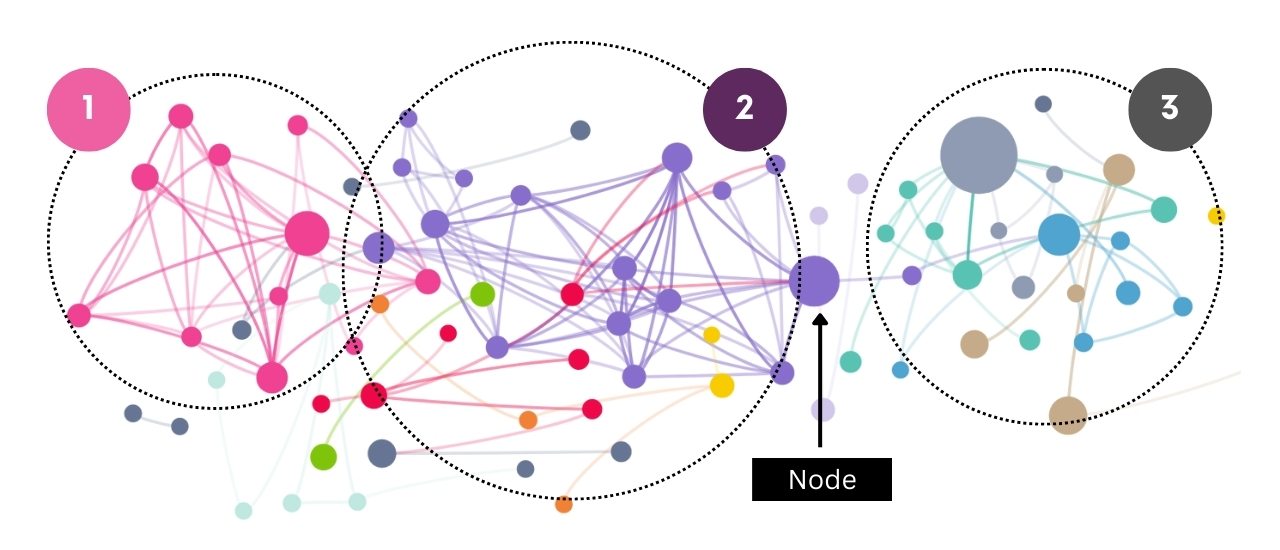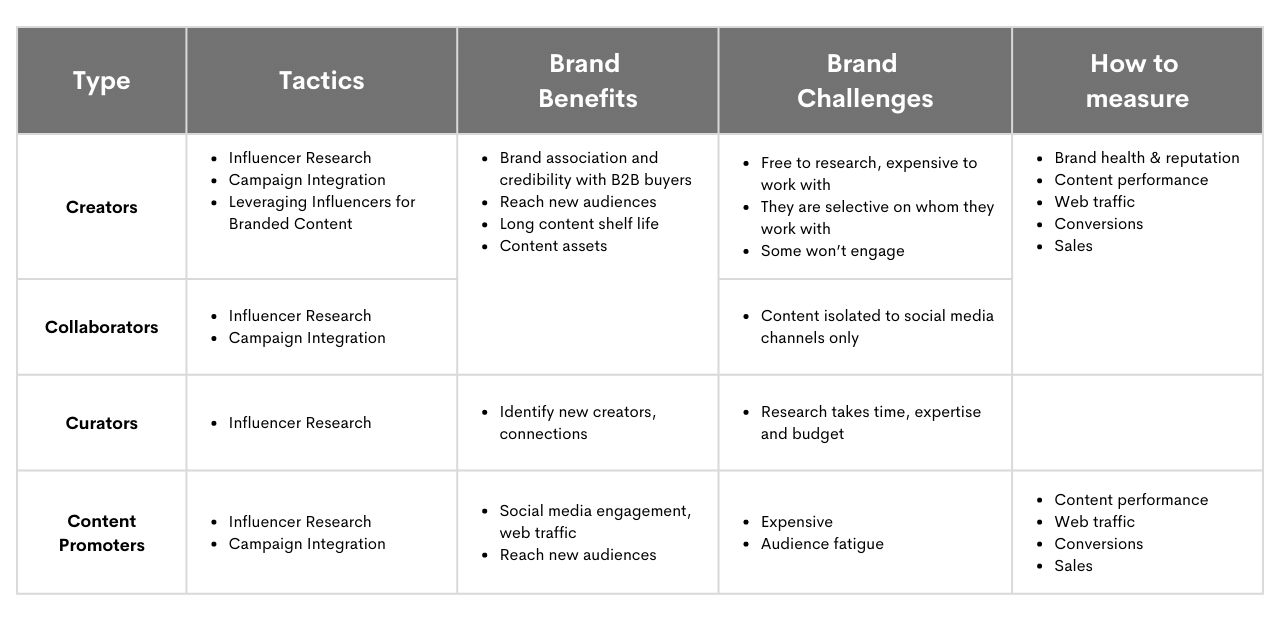Not all B2B influencers are created equal, and it’s more complex than B2C.
Why it matters:
B2B marketers need to consider many factors when determining who the most influential people are in their industry and how to work with them.
Over the years, I have become a B2B influencer marketing apologist. It sounds silly, I know. But it doesn’t get the credit or attention it deserves. It’s a booming industry, and several technology companies invest millions of dollars annually in building influencer marketing programs.
Most industry case studies and media coverage is focused on consumer brands activating cool programs across platforms like TikTok, Instagram, and others. I can understand why. These are new channels, new platforms, and influencer marketing is still a newish thing. B2B marketing doesn’t have that same level of hype and excitement.
For consumer brands, influencer marketing has shifted. In the early days, influencers were simply called influencers. Then as new platforms emerged, the segmentation of influencers happened based on audience size:
- Nano influencers (1K–10K followers)
- Micro influencers (10K–100K followers)
- Macro influencers (100K–1M followers)
- Mega or celebrity influencers (1M+ followers)
These terms are less relevant today. The marketing and media industry now refers to influencers as creators, although audience size is still important when evaluating the creator economy.
This language makes sense. Social media platforms are made for content creation.
Some might argue that B2B marketers are laggards when adopting new channels, creative advertising, or launching innovative digital campaigns. It’s a generalization, but it’s somewhat true.
And while B2B tech companies are delivering on innovation and launching cool programs, it’s time to elevate new ideas around influencer marketing.
First, let’s start with language.
We should move on from B2B influencers and start referring to them as B2B creators. But doing so raises an important question.
Do all B2B influencers create content?
The answer is no. They do not. Over the last several years, I have been working on a framework that isolates influence by behavior and tactic. There are different levels and types of influence based on content creation, collaboration, sharing, and the spreading of information, like the 1:9:90 Model of Influence.
The below influence model is the first step in doing that.
Deconstructing the B2B Creators Influence Model
This B2B Creators Model of Influence can be used to segment the community and help identify who to partner with and how. The B2B influence model can be broken down into four segments–creators, collaborators, curators, and content promoters.
B2B Creators
B2B creators do what the title suggests–they create. Unlike the creators that consumer brands collaborate with, B2B creators do it differently. They create thought leadership content.
Tech content creators bring new ideas, thoughts, and insights to the market, and they do it in several different ways. Many write long-form content on LinkedIn, Medium, Substack, or their personal blogs. They may also have their own podcasts, newsletters, and YouTube channels or post frequent bylines in the top business and tech media outlets.
Other B2B creators use short-form storytelling and produce content on LinkedIn, Twitter, Instagram, and TikTok. They are often quoted in the media, cited in analyst reports and briefings, or invited as guests on top-tier podcasts.
When B2B creators publish content, it travels far and quickly across the internet. And that content indexes quickly in Google, resulting in high rankings in the search results.
Examples of paid B2B creator campaign tactics include:
- They create content exclusively for a tech company to post on their branded channels
- They create campaign content for their personal channels
- They co-create video content with other creators, brands, interview executives
- They participate in company and industry events
Some tech content creators don’t even consider themselves creators, so they may not be open to a paid collaboration.
B2B Collaborators
Collaborators are like creators. They have original thoughts and ideas but don’t have a large platform outside of social media. They typically collaborate with other B2B creators or directly with tech companies.
In the past, they were referred to as social media influencers, but this isn’t an accurate description. B2B collaborators are also thought leaders and will share their expertise on a given topic.
Brands partner with B2B collaborators the same way they would with creators. There’s no difference in how campaigns or programs are executed.
Over time, many B2B collaborators become creators by expanding their reach outside social media.
B2B Curators
Curators have different roles in the B2B creator ecosystem. They curate content from other creators. They also add their own context to the original thought or idea by providing a unique perspective.
Brands don’t necessarily need to collaborate with this group, but they must understand who they are. From an analytics perspective, B2B curators are the nodes that connect different creator networks. They connect disparate thoughts, ideas, articles, reports, and influential people into a clean taxonomy ripe for analysis.
Here’s an example:
The below network map shows three distinct creator networks. The first two are connected through several nodes. Depending on the data set, a node can be content, topic, community, or in this case, a creator. The third network has no connections to any of the creators in the first network. However, there is one connection point to the second network. This is an example of a node. This node is a creator who is connected to multiple networks.

When B2B curators publish content, they provide breadcrumbs and connection points to other disparate creator networks. This is a gold mine for marketers.
This is not to say that curators aren’t creators. They are, but just not at the same level. Over time, it’s typical for them to evolve into creators once they gain the credibility and confidence to do so.
B2B Content Promoters
Content promoters are experts at building community. They have been using social media for a long time and understand what types of content work in each channel. They use marketing automation and other growth-hacking techniques to increase the reach, sharing, and engagement of their content.
They curate and distribute content and news differently, depending on the channel. Their role is slightly different from curators, though. Curators will include content from creators and provide more context, which adds value to the original thought or idea. Content promoters will align their content mostly to trending topics and news.
While content promoters might add some context to the content, it’s usually surface-level insights and not that deep. The benefit of working with content promoters is they can create engagement and drive traffic to a website.
Here’s a simple example:
- Brand A collaborates with three to four content creators for digital campaign
- The creators write blog posts, eBooks, and white papers and post that content on their personal channels
- The creators also live stream, produce videos, and participate in audio chats with Twitter Spaces, Clubhouse, or other channels
- Brand A also collaborates with content promoters, and they are responsible for packaging up and promoting all the creator’s content
B2B Influence is Complex
The B2B creator framework can help you identify and understand the different types of influence within a topic, vertical, industry, or community. It’s common for frameworks to shift, change and eventually become irrelevant.
B2B influence is complex. Many factors come into play when trying to understand and predict it. The B2B creator influence framework is designed to be a lens that can adapt as our understanding of influence changes.
B2B Creators Tactical Considerations
Below, you’ll find a matrix highlighting the B2B Creators Influence Model and the supporting tactics, benefits, challenges, and measurement framework.

FAQ
How different are creators that work in B2B versus B2C?
B2B creators are focused on creating content that educates and informs their audience about a specific topic, industry, or product. The content is usually long-form, and it’s more about the substance of the topic versus the style. B2C creators focus more on creating content that is entertaining and engaging. The style is usually more important than the substance because it’s designed to capture audience attention within the news feed.
What is thought leadership content?
Thought leadership is original content that provides insights, perspectives, or solutions to problems that exist in the business world. The goal is to educate and inform audiences so they can make better decisions.
What are some examples of thought leadership content?
Examples of thought leadership content include blog posts, articles, guides, white papers, ebooks, research reports, and infographics.
Can you give an example of a top content creator for B2B and tech?
Yes, I have personally worked with Sarbjeet Johal. He’s based in Silicon Valley and has worked as an engineer at large tech companies like Oracle, Rackspace, VMWare, and Dell EMC. He’s an analyst, influencer, consultant, podcaster, and B2B content creator.
